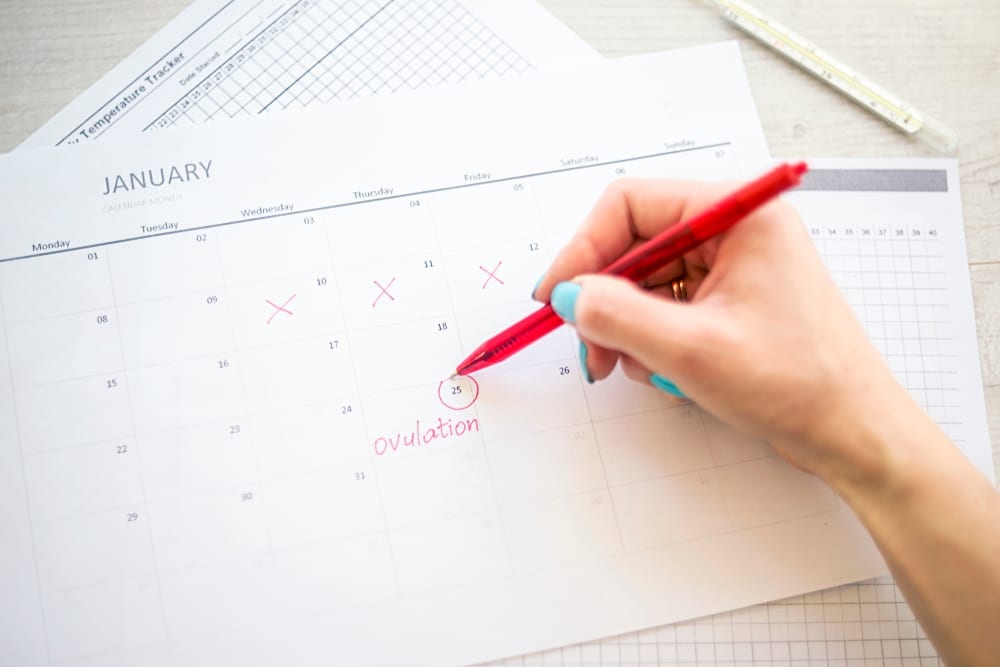Read Time: 3.5 minutes
TL;DR
- Ovulation occurs when one of a woman’s ovaries releases an egg that travels down the fallopian tubes where it may be fertilized by sperm, implementing into the lining of the uterus.
- Ovulation typically only lasts one day and occurs approximately two weeks before a woman’s period begins.
- Because you are the most fertile during ovulation, having sex with your partner during this time may increase your chance of becoming pregnant.
- Because ovulation varies, it can be difficult to pinpoint exactly when you will ovulate, but methods such as checking your basal body temperature or using an ovulation kit can help you to track your ovulation.
- The signs and symptoms of ovulation vary from woman to woman but may include things like breast tenderness, changes in cervical mucus, increased sex drive and more.
- Although you may not ovulate if you have recently had a baby and are breastfeeding or pumping, it’s still a good idea to use some form of birth control as ovulation can still occur.
While some women get pregnant on their first try, it’s very common for parents to have to plan around the optimal time for pregnancy to occur. If you and your partner want to have a baby, learning about ovulation and its signs and symptoms will better help you to identify when you’re most likely to get pregnant.
What is Ovulation?
Ovulation occurs when one of a woman’s ovaries releases an egg. After the egg is released, it travels down one of the fallopian tubes where the egg may be fertilized by sperm and implant into the lining of the uterus.
Ovulation typically only lasts one day and occurs approximately two weeks before a woman’s period begins. For example, a woman with a 28-day cycle may experience ovulation halfway through her menstrual cycle at 14 days. Because the length of the menstrual cycle is typically in the range of 26 to 35 days, ovulation can vary from woman to woman.
Ovulation and Pregnancy
If you and your partner want to have a baby, it’s important to keep track of when you may be ovulating. Because you are the most fertile during ovulation, having sex with your partner during this time will increase your chance of becoming pregnant. Though some people think sexual intercourse must occur on the day that you ovulate to become pregnant, most women have a six-day period when they are fertile. Most experts recommend that having sex one to two days before ovulation and during ovulation will give a couple the strongest chance of becoming pregnant.
How to Predict When You Will Ovulate
Because ovulation varies, it can be difficult to pinpoint exactly when you will ovulate. Using the following methods can help you determine when you are ovulating:
- Checking for an increase in basal body temperature (BBT) — At the beginning of the menstrual cycle, most women have a steady BBT of 97.2 to 97.6 degrees Fahrenheit. As your body nears ovulation, temperatures will slightly decrease and then rise. When your BBT is 0.4 to 1.0 degree higher, this indicates ovulation. Because BBT temperatures can vary, monitor it for two to three months for best results. Use a special thermometer designed to measure BBT to take your temperature while you are still in bed after you wake up.
- Using an ovulation kit — Over-the-counter ovulation kits measure the level of luteinizing hormone in your urine. After the levels of this luteinizing hormone peak, ovulation typically occurs within 24 hours.
- Menstrual tracking — If your menstrual cycle tends to vary, keep track of when it starts and stops for several months. Midway through the cycle, you can note any physical ovulation symptoms that occur to narrow down when you are ovulating.
- Using a fertility monitor — Fertility monitors differ slightly from ovulation kits in that ovulation kits give you a 24-hour window of when you will ovulate, while fertility monitors use your estrogen and hormone levels to identify the two peak days that you are most fertile.
Signs of Ovulation
The signs and symptoms of ovulation vary from woman to woman. Some women have strong symptoms during ovulation while other women have such subtle signs that it can be hard to distinguish when ovulation is occurring. These signs and symptoms occur due to hormone changes in the body prior to ovulation. Some of these signs and symptoms include:
- Heightened sense of smell, which can help your body be more alert to male pheromones
- Breast tenderness or soreness
- Changes in cervical mucus, which can be sticky and stretchy or wet and slippery. This mucus can be felt by either wiping your vagina with tissue and removing some of the mucus or by washing your hands and inserting one finger into the vagina.
- Light spotting that can be red to dark brown in color
- Pelvic pain or cramping
- Softer and more open cervix. This can be checked by inserting a clean finger into your vagina and touching your cervix gently. During ovulation, it will feel softer (like a pair of lips), while after ovulation it becomes firmer (like the tip of a nose).
- Increase in sex drive
Breastfeeding and Ovulation
If you have recently had a baby and are breastfeeding or pumping, you may not ovulate. Unless you are ready to have another baby, however, it’s a good idea to still use some form of birth control as ovulation can still occur.
Trying, wanting and waiting to get pregnant with a baby of your own can be a frustrating time for many women. Being patient, communicating with your doctor and tracking the signs and symptoms of when you will ovulate will help increase your chance of having your own little one.



 Complete Our Simple Online Form
Complete Our Simple Online Form We’ll Handle All The Paperwork
We’ll Handle All The Paperwork Receive Your Free Ameda Pump
Receive Your Free Ameda Pump